How Landscaping Can Lower Heat Gain in Your South Florida Home
How much heat your home lets in – also known as heat gain – will influence not only how comfortable you are throughout the year in our warm Florida climate, but how much you pay in cooling bills. A variety of factors can either increase or decrease heat gain in your home. Air sealing, insulation and heat-generating equipment inside your home can either make or break your energy costs. A lesser-known factor, landscaping, is one area where investing in reducing heat gain can create significant savings.
While landscaping will require an upfront investment, and perhaps a sizable one depending on how much existing vegetation your home has, after it’s in place, it can help you to eventually recoup that investment. Then it will continue to pay you back in terms of monthly energy savings – as much as 30 percent – for many decades.
To block the sun’s rays against your home, the University of Central Florida recommends using the following guidelines to strategically plant landscaping to lower heat gain:
- Plant trees and shrubs that provide shade against walls. Relying on tree growth to shade the roof takes much longer and is less cost effective.
- Focus on walls on the west of your home, which are susceptible to 50 percent more heat gain than walls on the north and south. While one would think the south side is also a good place to reduce heat gain with landscaping, the angle of the sun is so steep for most of the day, that a roof overhang is probably a better way to block the sun’s rays.
- Choose plants and their location so that within five years they will provide shading within just a few feet of your home’s roof, which will ensure that they shade the majority of your home’s walls and any windows.
- As you plant, make sure windows are strategically shaded by vegetation, as the most heat gain occurs through them.
- As a general rule, to provide shade during the afternoon when heat gain is at its highest, position landscaping fairly close the home. Compared to a tree planted within 20 feet of the west wall, one planted 10 feet away can offer four times more shade over the height of cooling season.
Why not invest in a long-term, energy-saving landscaping project and lower your home’s heat gain during our seemingly endless cooling season? Contact NisAir Air Conditioning & Heating today. We’ve been providing quality HVAC services to homeowners in Martin, Palm Beach, St. Lucie and Indian River counties since 1973.

